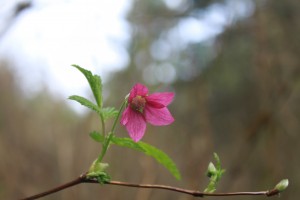
Natural Beauty
After a weekend filled of adventure and excitement I spent most of my Sunday relaxing, reading one of my new books that I found at the great used bookstore in Friday Harbor. Fittingly titled “Serendipity” this quaint little shop stole my heart with its book-filled walls, floors, and ceilings of every imaginable book genre. Despite the draw from the variety of sections, I somehow found myself hunkered down on a stool in front of a shelf full of books on my favorite subject…whales. Before discovering this gem of a shop, my Saturday morning started off with a misty row across the harbor into town. As a group, we wanted to spend our first Saturday adventuring around town together. This of course included visiting the one place we had wanted to go to all week, the Whale Museum.
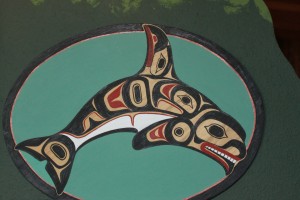
Native Killer Whale Carving
Finding myself wandering around the museum surrounded by hand painted whales swimming across the oceanic walls with the sounds of orca calls filling the air, it finally began to sank in. This experience that I have been dreaming about for years, is finally becoming a reality. I felt like a little kid again, bubbling with uncontainable excitement. That day spent exploring the town, as a group was great. We have already begun to make so many memories here on this enchanted island. The day granted me one more surprise when we ran into an old acquaintance of mine at the movie theatre, Captain Jim Maya. Captain Jim runs one of the local whale watch boats here on San Juan Island. He took my mom and I out whale watching about three years ago. It was the first time I that I saw orcas in the wild, and I will never forget it. I very much attribute my participation in the Beam Reach program to that affirming experience. The phrase “it’s a small world†doesn’t justify our run in with Captain Jim. The sense of community on San Juan Island is incredibly strong. I have a feeling that we will only find ourselves getting more attached to the kind and interesting people that make the atmosphere of Friday Harbor irresistible. Every day I can sense that we are building ourselves a new type of community as a class, and meshing it with the existing one of Friday Harbor.
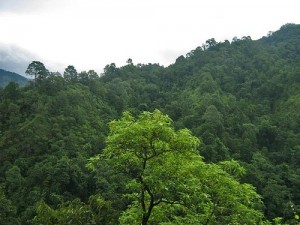
Nepalese Forest Ecosystem
My favorite aspect of the Beam Reach Program is the continuance of my education; we never stop learning, even our break times are filled with academic discussions and inquiries. The other beautiful part of this program is the power the individual student is given to create our own education. Although the resident orca whales intrigue all of us, we also have unique interests outside of the Beam Reach course. Providing us with an opportunity to share those interests with the class, our assignments often ask us to choose journal articles for group discussion. The common thread among all of the articles being that they involve or discuss the practice of sustainable science. When thinking about a case study that I was personally interested in learning about, I instantly thought of Nepal and my hopes to travel there next spring to study community forestry and sustainability. Fittingly, the paper that I chose to discuss with the class is “Capital Formation and Community Forestry in Nepal”. Community forestry in Nepal has become a vital thread of sustainability and environmental conservation. This paper examined the role that capital formation plays in the community forestry process. Specifically, it looked into what characteristics determine the success of a Forest User Group, the title of the community forestry groups, what the generated capital is used for, and the affect this has on the community’s views of the forestry system. What the study found was that the management of their sales, and the type of forest they were managing determined the success of a Forest User Group. In almost all examined cases, the generated capital was primarily used to benefit the community in education.

Coastal Community
Overall, a positive change in attitude towards the system of community forestry was also demonstrated. I feel the paper really demonstrates that giving power and responsibility of the local environment to the community that it affects results in  benefits for the community, as well as improved conservation of the environment. I feel that community management methods are incredibly sustainable, and although the transition period may be difficult if they are given the proper skills, the outcome will outweigh any costs. Reading about the success of community resource management in Nepal got me thinking about community resource management in the San Juan Islands. This community cares a great deal about the local environment and the ecosystems that keep it pristine. I can’t help but wonder what the state of the herring, salmon, orca, and other marine animals would be if community resource management were implemented. Would they be in a better or worse state than they are today? It is hard to say, but I hope to think about this more as the weeks progress. The week ahead promises more mind expansion with multiple guest scientists visiting and lots of afternoons spent out at Lime Kiln Lighthouse.
Read More
A week has already gone by since we moved into Friday Harbor and we have been keeping busy with class and continuing our discussions on sustainability. In my reading I came across a really interesting paper called  Sustainable resource management coupled to resilient germplasm to provide new intensive cereal-grain-legume-livestock systems in the dry savanna. Try saying that 5 times fast. Although it seems a bit daunting its a really fascinating concept. In sub-saharan Africa people are dealing with increasing populations and demand for products while still restrained by the arid climate. After years of research from the ITA (Institute of Tropical Agriculture) researchers found that farmers were hesitant to implement potentially costly technologies without seeing immediate economic profits.
So the focus for the last 10 years has been on cereal-legume and crop-livestock systems where farmers make most of their money. After developing and testing several ideas researchers found the following to be most successful and profitable. They used promiscuous soybeans and dual-purpose cowpea lines which are more efficient at fixing nitrogen. Now don’t worry, its been a while and I wasn’t even sure about the definition of nitrogen fixation, I had to look up. It is the process of changing the structure of nitrogen in order to  free up nitrogen atoms so that they can freely interact with other chemicals. This is important because nitrogen is needed to biosynthesize the basic building blocks of plants. So more efficient nitrogen fixation results in greater crop production. Another problem farmers are facing is a weed called striga which is killing their crops. A soybean they have been working with is able to bring the striga to premature “suicidal” germination. After implementing these two ideas on several farms, farmers saw immediate results. On average crops showed a $1,233 dollar increase per hectare of crop. I think it is very cool that scientists and farmers were able to work together and mitigate a specific problem using crops they already had. By understanding the properties of crops they were able to develop a rotation system to maximize profit.
We’ve been continuing our work on sustainability but are now starting to branch into the research aspect of our course. Over the weekend we put together data sheets for gathering data at Lime Kiln this week and the next. hopefully our luck seeing the Orcas will improve. At the moment we’re working on designing some sort of whale song and dance to call the whales to us, since telepathy hasn’t been working. Either way it’s going to be an exciting week at Lime Kiln.
Read More
It seems like the fun never stops! Our first weekend on San Juan Island was fun-filled and packed full of adventure. The group decided to stay relatively local and explore the quaint town of Friday Harbor. Friday Harbor, although on first sight may look relatively small, in fact has many stores, parks, and of course a beautiful ocean front waiting to be explored. Because the weather looked promising we decided to take a fifteen minute row into town. This gave us an opportunity to see the island from the water; whetting our appetite for the weeks to come.  You get a completely different perspective from being in a little row boat among the larger, and might I add, fancier sail boats. Given our energy and enthusiasm, we headed straight to the whale museum.  The Friday Harbor whale museum is dedicated to promoting whale and environmental stewardship through a variety of displays, artifacts, and presentations. What a fantastic resource we have right on our door step. One of my favourite exhibits was the ‘whose your daddy?’ display.  I particularly appreciated having a visual of the matrilineal lines within the southern resident community (as genealogy often gets confusing). In addition to visiting the whale museum, we were able to wander around town. I loved discovering a used book shop called ‘Serendipity’ (it certainly lived up to its name). It was like walking in a cave of books—piles of books stacked from floor to ceiling. I could have spent hours looking through the, hundred or so, shelves.
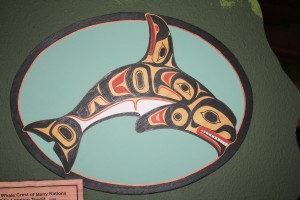
Odin Lonning Tlingit- Killer Whale Crest of many nations
Throughout the weekend, I have continued to contemplate the concept of ‘sustainability science’, and the things I can do, in my research, to become a more conscious scientist. In light of this, the class calculated the total amount of energy consumed from five everyday objects. Given we will be living on the Gato Verde in a few weeks, energy consumption is an area we all need to be mindful of. In addition to this exercise, one of the assignments from the latter part of the week provided some food for thought. We were required to find a paper/case study on any topic of interest, as long as it fell within the sustainability science realm. I chose to research fisheries with a focus on community-based management. Last year I took a class on marine policy, and took a particular interest in community-based fisheries management as a way of promoting alternatives to centralized systems. My paper titled ‘The Context of Policy Design for Existing Community-based Fisheries Management Systems in the Pacific Islands’  looked at community-based fisheries management in a number of small Pacific Islands including Papua New Guinea, Vanuatu, and the Solomon Islands. My paper was very informative in terms of providing the reader with a good overview of national policy and highlighting some of the obstacles associated with implementing such a system. However, because the paper lacked data, it was challenging to analyze existing management schemes in relation to population trends of various species. If I was to continue with this project I would make every effort to collect data to be used as evidence to support this alternative approach to fisheries management. One thing I will take away from the paper is that there is a need for interdisciplinary research that combines human ecological, biological, and economic approaches. Interestingly, Bre’s paper also chose to focus on community-based management (this time regarding forestry in Nepal). Many parallels could be drawn between both our papers.
On a separate note we, as a group, have started to create our own data sheets for the research to be conducted at Lime Kiln. Over the next few weeks, we are going to be looking specifically at marine mammal, sea bird, and vessel abundance (and behaviour). Although the proposed data sheets are still in draft form, we are confident that they cover an array of potential observations. In preparation, we had a ‘birding lesson’ today with Jason Gunter. Despite the windy conditions, we were fortunate enough to see many Bald Eagles, in addition to a few Oyster Catchers, and the odd Cormorant.
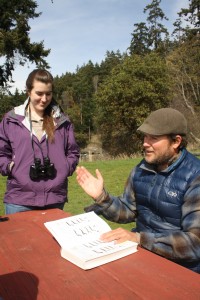
What bird is it?
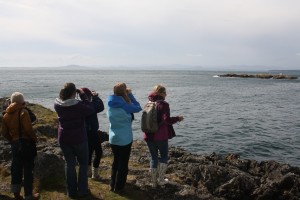
Avid bird watchers in action
The close of a highly educational and enlightening week brought with it the start of our first weekend here in Friday Harbor! I wasn’t really sure how much better my experiences here on the island could get since everything that has happened so far has been more than I expected, but I can see clearly now that my adventures have only just begun. Thursday night, we ventured to the opposite side of the island (near Lime Kiln) to a place called English Camp with a group of other students from the labs. The story behind English Camp resulted from a rather daring pig encroaching upon American crops. Supposedly, some hostility arose between the British and the Americans after the pig demolished a few crops and was killed for trespassing. Thus, a fight broke out and the island of San Juan was forevermore considered American soil. What an extremely silly pig!
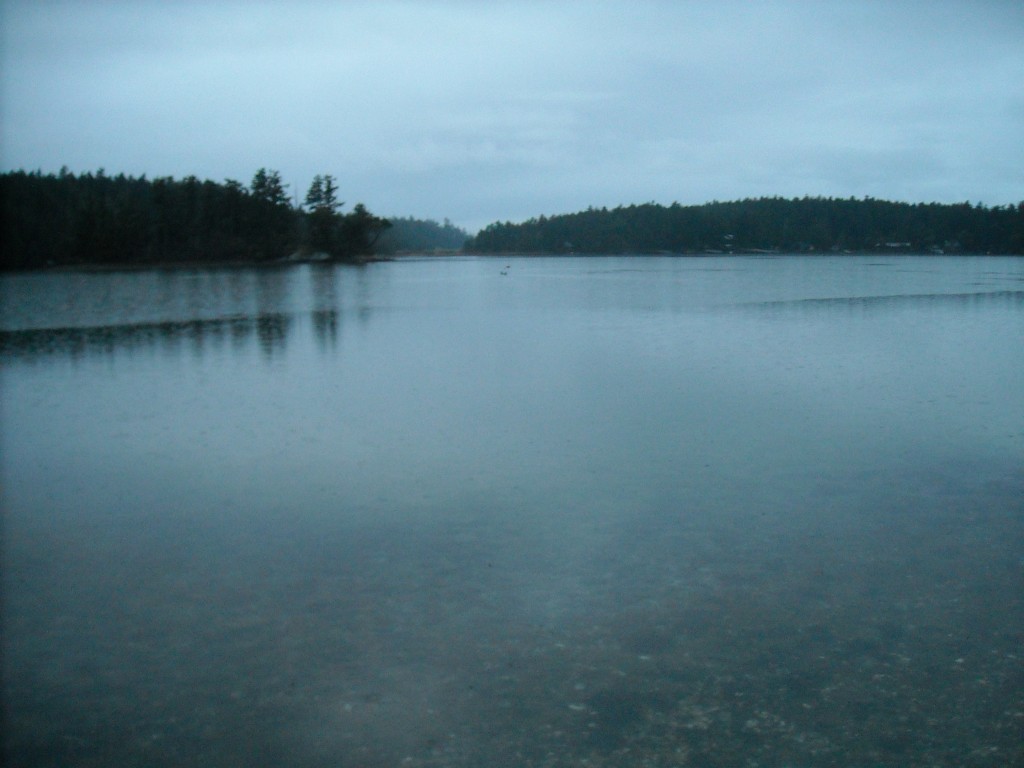
English Camp's ocean view
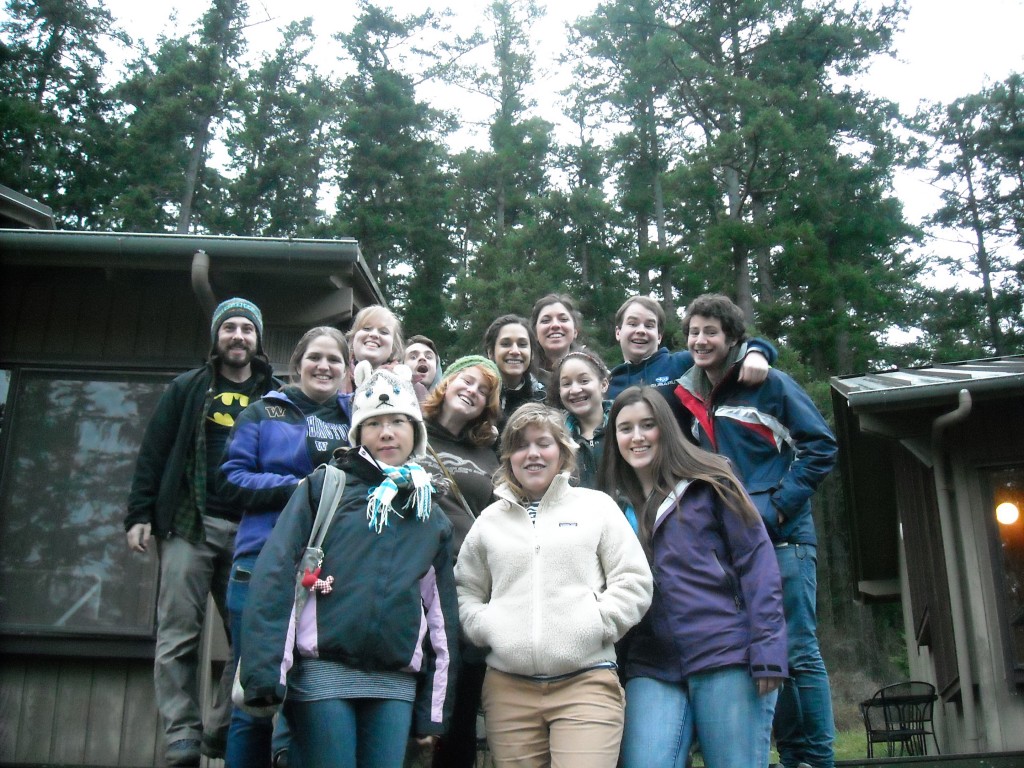
New friends!
Friday’s class opened with a group discussion on different case studies we each chose to read and present. The studies focused on sustainability science, but instead of encompassing the subject as a whole, they honed in on specific examples of the science in action. The study I chose looked at improvements experienced by farmers in developing countries after they adopted more sustainable farming practices, based on a response to a mail survey. It was titled Reducing food poverty by increasing agricultural sustainability in developing countries. It was interesting to find that with subtle changes like soil health improvements, using water more efficiently, and either decreasing or eliminating pesticides completely, the increase in per hectare food production was 93% (a hectare is about 100 acres)! The study took place in developing countries in Asia, Africa, and Latin America, so in order to ensure economical and social support, the changes that occurred encompassed low costs and local availability. I am still a little bit skeptical of the results of the study because they were based on a mail survey and feel that there could have been more accurate results if the data had come from scientists actually in the field, but it was still cool to see such a dramatic improvement.
After class on Friday, the six of us rowed to town (I am still trying to convince myself that this is real). We wanted to stock up on ice cream and cookie dough for our future movie nights! When we returned, we happened upon an exciting gathering in the dining hall. There were quite a few students socializing with fun music and games and it was great to get to know everyone from all of the different programs that the labs have to offer.

Learning to Row
Today (Saturday, March 31), we rowed to town again to explore the Whale Museum and to see the Hunger Games. The Whale Museum was a fantastic place to brush up on and review my knowledge of a few things we learned in class this past week. After visiting the museum, we meandered through town and came across all sorts of fun little shops, like a used bookstore called Serendipity, where I purchased a book called The Life of Pi. I have always been really picky about buying used books, but I couldn’t risk never knowing the survival story of a boy and a tiger. More importantly, I feel like I have made a small step in advancing my sustainable lifestyle. On a different note, The Hunger Games was very intense! I think it really did justice to the book and I can’t believe how much I can’t stop thinking about it. I am glad I was able to share these experiences with my new friends. After all, every adventure is better when you are in good company!
Read More
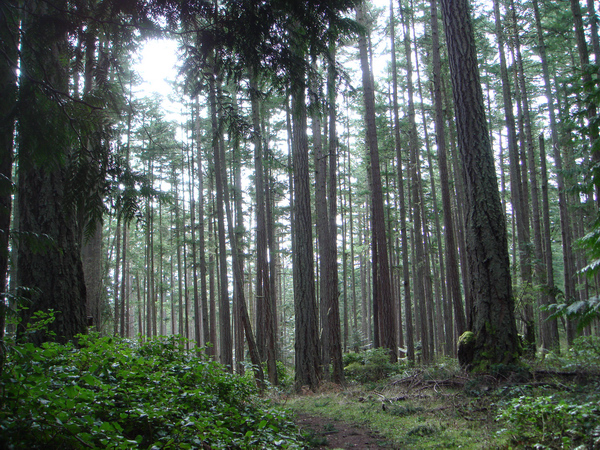
Our Classroom
This week the S Pod, as we Spring 2012 Beam Reachers are now called, discussed at length about “sustainability science”. So, what is sustainability science? Each of us has a unique definition of what sustainability means to us, and many writers have proposed a variety of definitions.
My personal definition of sustainability has its foundation in the very meaning of the word “sustainable”. The word sustainable connotes, first, the “capability to be sustained”, and second, “using a resource such that the resource is not depleted or permanently damaged”.
In implementing a “sustainable project”, it is important to make sure the project can be continued on a long-term basis. I recently visited a rural village in the Samburu region of Kenya, where NGOs have installed water filters for rainwater reservoirs. However, when I was there, the water filters were not functioning because the NGOs had failed to adequately educate the local community in how to properly use the filters. Therefore, one could say that this project is not sustained, and such a project is not sustainable if the local community does not get involved.
How does the above example translate to sustainability science, and in our case, environmental conservation? One of the most important element in sustainability is education. By imparting the knowledge and idea pertaining to one’s project to the local community, the local people could then become the engine of the project, and these knowledge, ideas and good practices could hopefully be passed down to the next generation and inspire students to become field-level experts.
Two days ago, Katie Fleming from REsources, an NGO based in Bellingham, WA, shared her experiences in community outreach. She implements a model which she calls “community-based social marketing”. This model markets an environmentally friendly idea or practice, such as to turn off the engine when the car is stopped for more than 30 seconds, by educating school children to influence their parents, giving small incentives, and by adding a “peer pressure” element”.
I feel that this is a wonderful practice in sustainability, in both aspects of ensuring the project is sustainable, and in promoting a more sustainable use of resources.
Moving on to the second definition of sustainability, which is the sustainable use of resources. The household definition of “sustainability” usually refers to the popular concept: to make use of renewable resources, and to reduce, reuse and recycle consumer products. One aspect of sustainability science could be to use a research method that is in line with the above practice, so that the research could be economically sustainable and have minimal impact on the environment.
Sustainability science in a larger scale would be to examine the current state of environment, and to encourage essential economic practices such as agriculture and transport, to move towards the sustainable use of our shared natural resources.
Our Beam Reach instructor, Dr. Robin Kodner shared with us her personal definition of sustainability during our round-table discussion. One of Dr. Kodner’s current research project is to measure the level of Domoic Acid, a neurotoxin produced by the diatoms Pseudo-nitzschia, in nearshore waters. Her hypothesis links higher levels of Domoic Acid in the water with altered water temperature or nutrients leached from agricultural lands.
Dr. Kodner’s definition of sustainability science is: using natural science methods to study the social and environmental interactions and changes, hence providing the data as a basis of better management and policy. And also, to come up with innovative solutions.
In Kenya, our class did a small insect abundance and variety survey on subsistence farms. Our investigation was brief, but we compared and critically assessed the condition of the two farms. The overarching goal of such a survey was to reduce pesticide use by relying on native species to reduce herbivory on crops. One method is to have weedy margins to agricultural plots. Reducing pesticide use reduces the amount of toxin that could be leached into streams or groundwater, which helps to ensure the sustainability of local water resources.
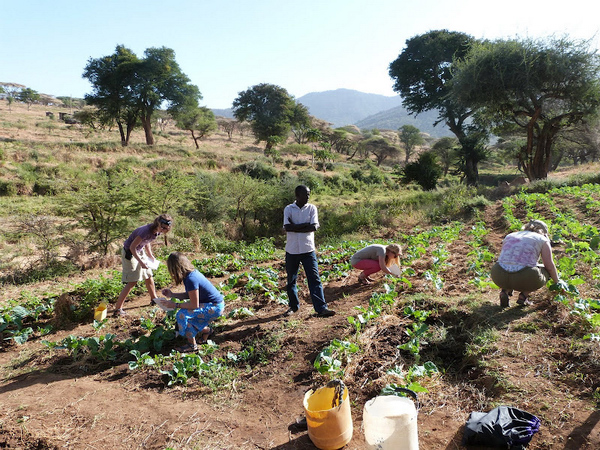
Insect Abundance and Variation Survey in Kenya, 2012
I am really glad that my experiences in Kenya have enabled me to contribute ideas in this class. My current research direction is to find out what aspects of orca conservation might human interest come into conflict against. I look forward to learning more about the Salish Sea and my beautiful classroom — San Juan Islands!
Read More
It is hard to imagine that there could possibly be a more beautiful environment to learn  in. Waking up every morning to the snowy peaks poking their heads over the emerald islands to greet me, and remind me why I am here. It’s so important that the irreplaceable and enchanting ecosystems that make up the San Juan Islands are preserved.
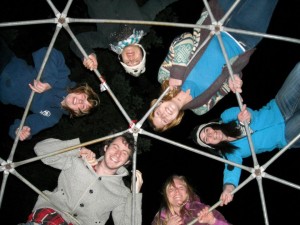
This first week we have talked extensively about what sustainability science means to us, and the different ways we can practice sustainability over the next nine weeks of our course. At home I try to live a sustainable life style, but I have never considered the different ways sustainability can be practiced when doing science. To me sustainability science is the practice of environmentally conscious science that aims at furthering our knowledge of effective ways humanity can live in balance with nature.
We have only been at the Friday Harbor Labs for a week, and although we have yet to see any orcas, there has been no lack of thing to do, and people to laugh with. After a week packed with learning we finally had a chance to go to the whale museum today! http://www.whalemuseum.org/ What an amazing resource to have right in our backyard!!
Read More
I look out of the window to see the great pines of the west coast, lush green fauna, and the blue-green waters of the harbor drawing me out to explore as I write from the UW Friday Harbor Labs on San Juan Island. I still remember the first time my mom and I came to visit the San Juan Islands; I have been waiting to return ever since. There is something incredibly special about this place. Often whilst walking around I feel there is magic in this fresh, salty air that blows in from the sea.I am not sure what has been more captivating to me during this first week, the scenery or the academic atmosphere I have been immersed.
From the moment our class sat down on the ferry the educational immersion into the Pacific Northwest ecosystem began. Each of us had enthusiastic curiosities about the ecology of the San Juan Islands and of course the Southern Resident Orca Whales that live here. I knew I was with a great group of people from the start. Our first week has been filled with many adventures, both in and out of class time. No matter what we are doing I can guarantee that there will be sounds of laughter, singing with guitar playing, and lots of whale talk present.
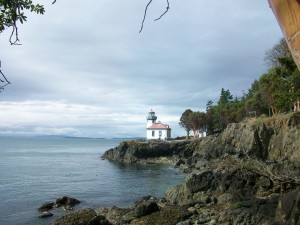
Lime Kiln
The weather has been a perfect introduction to living in the Pacific Northwest. We had a few days with misty rain and strong winds, but have also been incredibly lucky to get decent amounts of sunshine with clear skies. As a class we have made two trips to Lime Kiln Point this week where we have started our introductions to bio-acoustics and observing the ecology of the ecosystem.Lime Kiln is one of the most refreshing places to be. Making your way through the madrones trees down to the rocky shore, the breeze blows in from Haro Strait and it seems that life can’t possibly get better than this.
Of course, not all of our time can be spent out and about adventuring; we have also had lots of interesting lectures and stimulating discussions. Basic whale biology and the natural history of orca whales have been a major topic this week, as well as discussions about sustainability science. Sustainability science is an up and coming form of science that focuses on, you guessed it, sustainability and science. You may be wondering how one actually defines and practices sustainability science…well we have been thinking on this question for a good part of our class time this week. My personal definition has already begun to shape itself into something different than its origin. I think that it is best to first think about what it means to be sustainable. I believe that sustainability is the balance between the environment and human civilization that promotes a level of social equity which we are able to maintain for future generations. Sustainability science studies subjects with the goal of contributing to the search for the “sustainable balance†while also practicing sustainable methods throughout the research process. Looking ahead to the weeks to come, I am sure that both of these definitions will evolve, but I am enjoying each and every second that keep my brain wheels turning. This spring our class is lucky enough to be involved in the controversial Cherry Point coal terminal debate by contributing base-line data to the scoping process. Katie Fleming from ReSources for Sustainable Communities met with us for an afternoon to share sustainable ideas from the region, as well as give us an introduction to the impacts from the proposed coal terminal.
I look forward to spending more time learning about this particular issue and doing some “science” in two weeks when we make our first cruise on the Gato up to Cherry Point!
Read More
Ever since my freshman year I have been hoping I would get into the Beam Reach program and now that I have it feels slightly surreal. We moved in to the Friday Harbor Labs this past weekend and  just began classes on Monday. We have only been here a week and it feels like I have known my classmates for much longer. When not in class, which is a short amount of time, we have been exploring Friday Harbor, venturing to Lime Kiln, and even learning how to row in rowboats… sort of.

I can already tell this is going to be an amazing quarter and I am going to be sharing it with some really awesome people.
We have hit the ground running in class with discussions on sustainability and defining what it means to each of us. I have discovered that it is a very difficult concept to sum in a few sentences but I’ll give it my best shot. I feel that sustainability science is a science that investigates and promotes technology that combines human and environmental goals in order to sustain and preserve our natural resources for further generations. Here at Beam Reach we focus on marine science while practicing sustainability. We are committed to studying the resident killer whales while minimizing our impact on them by using a diesel electric catamaran for collecting research called the Gato Verde. We will get to go out on the boat in a few weeks for a test run up to Cherry Point and I cannot wait.
This is going to be an incredible adventure, I hope you’re all enjoying life as much as I am.
Read More
After an amazing two weeks Spring break travelling from coast to coast, I have finally made it to the idyllic Friday Harbor Labs in the San Juan Islands. It is difficult to give the place justice through words alone. I feel so fortunate to be living for the next ten weeks in a place where tiny evergreen islands litter the sea and snow capped mountains touch the lapping waters. How can anyone be expected to study in such a gorgeous environment full of distraction? I feel I constantly want to be outside exploring! In some respects the area reminds me of Maine, however, on a more dramatic scale. Since meeting the other Beam Reachers, in Seattle little under a week ago, we have embarked on numerous adventures together. It is so great to be surrounded by like-minded students who share a passion for conservation and the environment. If you wander past the ‘S1 duplex’, regardless of time of day, one can expect to hear music playing and the sounds of laughter in the air.  Yes, there has been lots of laughter! It has also been great integrating with the other students and researchers at the lab. Hearing about their work, I would argue that the quality and diversity of the research generated at the lab is astonishing.
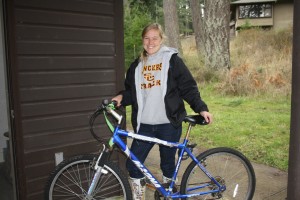
Rachel: Lots of exploring to do!
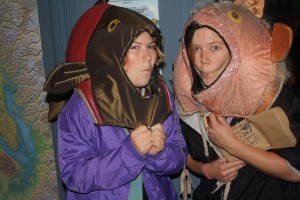
Did I mention loads of laughter?
As a class, it feels that we have already learnt so much; way more than I could have envisioned at the start of the week. So far, we have covered basic whale biology, killer whale family structure, population trends, and even dipped in to whale genealogy. In addition to the marine mammal component of this ten week intensive course, we are also learning the methods of practicing sustainability science. But what does this involve? After numerous discussions, both inside and outside of the class room, it has become evident that the scope of ‘sustainability science’ is broad, and the definition specific to each individual. Throughout the week, having grappled with some case studies and current literature, I have found my own personal definition to have evolved. At the moment, I would describe it as an interdisciplinary approach to science that takes into consideration local and global perspectives, whilst remaining conscious of environmental, social and economic factors. Through innovation, education, and the evaluation of current practices we can both mitigate and minimize our footprint on both a regional and global scale. Because this is still a working definition, my hope is to revisit and reference it throughout the quarter. I would encourage any readers to pause for a moment and think of their own definition. I would also like to draw the reader’s attention to RE-sources; a local organization run from Belligham, WA. (http://www.re-sources.org/home). Katie Fleming, a RE-source community outreach manager, came in to draw our attention to local sustainability science issues, and the things we [students] can do to get involved. I was particularly impressed by the examples she gave that highlighted various methods, such as workshops and citizen training, used by RE-source to empower local communities.  Hearing the perspectives of an outside source has been insightful. In addition to Katie Fleming, Lynne Barre from NOAA came in to give an overview of Southern Resident Recovery.
Given the success of the first week, I can’t wait to find out what next week has in store for us!
Read More
After a very long, ten day road trip, which began in Tucson, Arizona, I finally made it to Friday Harbor on the island of San Juan! My new home for the next ten weeks, the Friday Harbor Labs, is full of friendly people, sumptuous food, and a never-ending list of things to explore , like scenic running trails and quaint rowboats. Friday Harbor is one of the most beautiful places I have ever seen and I am so excited to embark on this enriching adventure with my new wonderful friends, Jamey, Breanna, Taya, Phinn, and Dana!
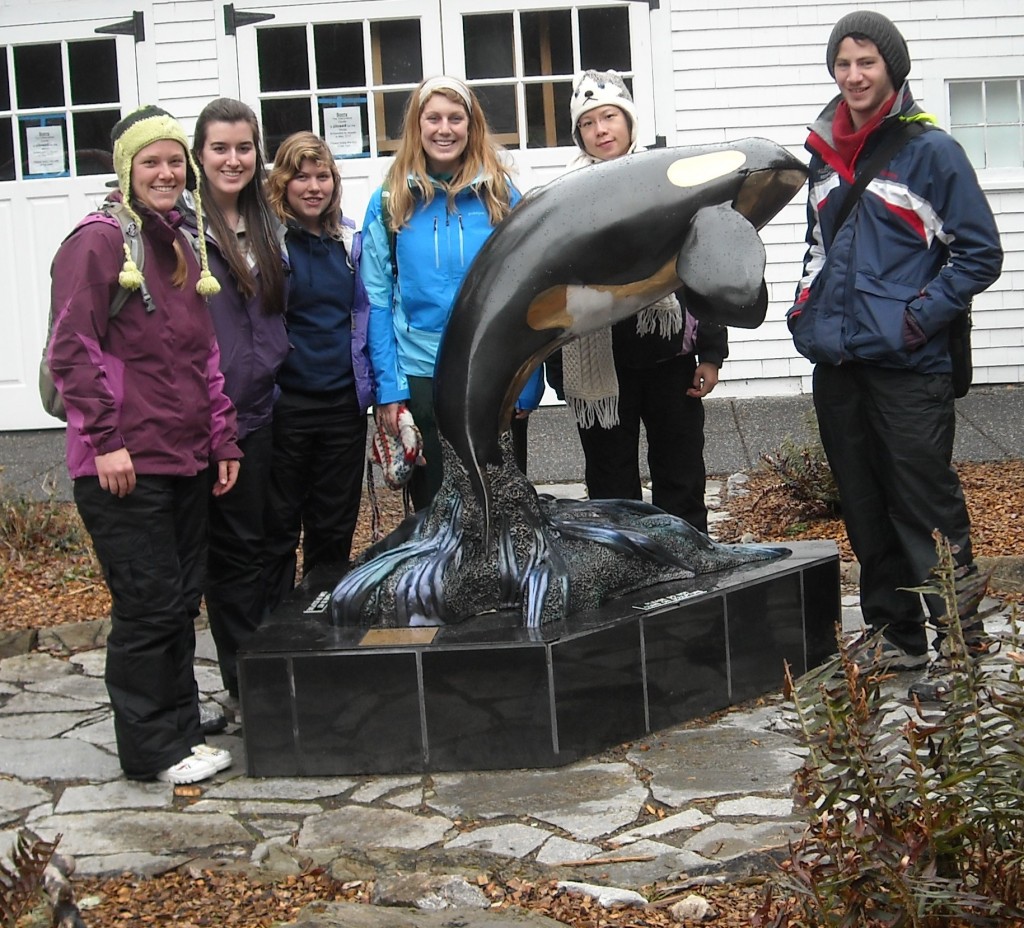
Me, Dana, Jamey, Breanna, Taya, and Phinn on our first excursion to Lime Kiln
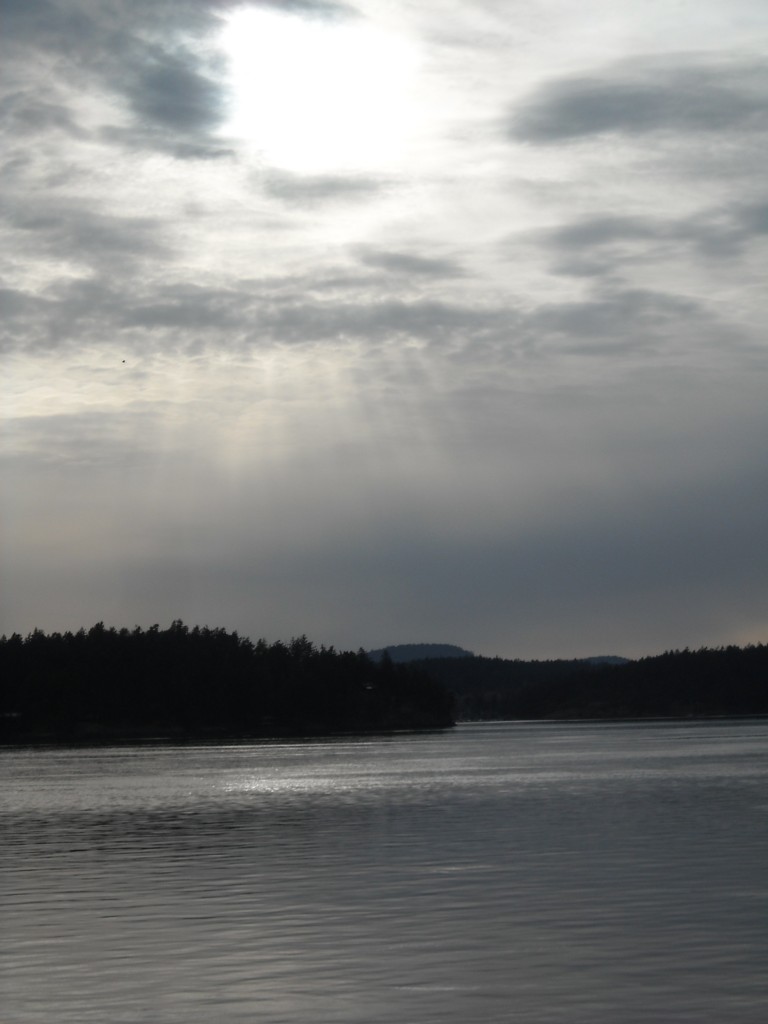
Class began on Monday, March 26 and has thus far been very interesting. We have learned quite a bit about killer whales and have just touched on the topic of sustainability science. Sustainability science does not have one set definition, but can be somewhat described as a combination of preserving the environment throughout the developments of the human population and improving scientific practices to sustain society. It is not only viewed through an environmental perspective, but also economically and socially. I found a description of sustainability science in a recently read paper to be rather enticing: enhancing human prosperity while protecting the Earth’s life support systems and reducing hunger and poverty. I felt that the emphasis on human prosperity in addition to protecting the environment was really cool!
Outside of the curriculum, I have had some great bonding time with my new friends. The six of us have managed to explore town, the rowboats, and the food menu, and are hoping that our upcoming adventures will provoke much more laughter and prove to be even more exciting!

Friday Harbor Labs
Read More





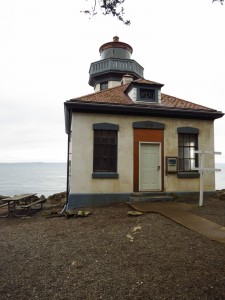


















 Twitter
Twitter LinkedIn
LinkedIn Facebook
Facebook